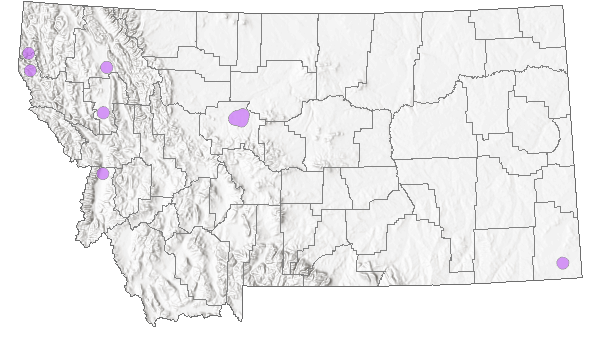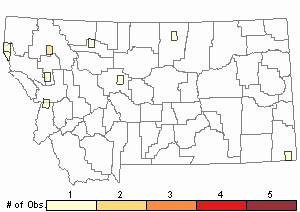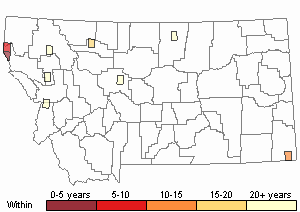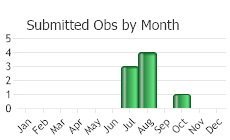View in other NatureServe Network Field Guides
NatureServe
Montana
Utah
Wyoming
Idaho
Wisconsin
British Columbia
South Carolina
Yukon
California
New York
Guadalupe Water-nymph - Najas guadalupensis
State Rank Reason (see State Rank above)
Rare. Currently documented from a few fresh water sites in the western and central portions of the state. Species is poorly documented in Montana and additional information on population levels, trends and threats is needed.
- Details on Status Ranking and Review
Population Size
Score1-2 - Small to Moderate. Population size is imprecisely known but is believed to be >2,000 individuals and <100,000 individuals.
Range Extent
Score1 - Peripheral, Disjunct or Sporadic Distribution in MT: Widespread species that is peripheral, disjunct or sporadically distributed within MT such that it occurs in <5% of the state (<7,500 sq. miles or the combined area of Beaverhead and Ravalli Counties) or is restricted to 4-5 sub-basins.
Area of Occupancy
Score2 - Low: Generally occurring in 4-10 Subwatersheds (6th Code HUC’s).
Environmental Specificity
Score1-2 - Moderate to High.
Trends
Score0-3 - Population trends are unknown.
CommentTrends are unknown.
Threats
Score0-2 - Low to High Threat Levels.
CommentPotential threats to the species' viability are unknown/undocumented.
Intrinsic Vulnerability
Score1-2 - Moderate to High Vulnerability.
Raw Conservation Status Score
Score
6 to 14 total points scored out of a possible 19.
General Description
Guadalupe Water-nymph is a submerged aquatic annual with slender, branching stems up to about 7 dm long. The opposite, ribbon-like leaves, usually with additional leaves in their axils, are 0.5-2 cm long and have minutely toothed margins and enlarged bases. Tiny unisexual flowers, both male and female on the same plant, are borne singly, without stalks, in the axils of leaves. The male flowers have a single stamen enclosed in a translucent bract which is surrounded by a firmer bract, and the female flowers consist of a single naked pistil. The fruits are single seeded with a thin, papery covering. The long tapered seeds are round in cross-section and are dull and coarsely pitted with 10-20 rows of pits across the middle.
Phenology
Flowering in July, with mature fruit in August.
Diagnostic Characteristics
Distinguished from other genera of submerged aquatics in Montana by its opposite ribbon-like leaves with expanded bases, usually with secondary leaves in their axils, and also by its solitary, axillary, unisexual flowers. Distinguished from the more common
Najas flexilis by having shorter stems, shorter leaves with short tapering tips rather than long tapering tips, and seeds which are dull and coarsely pitted rather than shiny with minute pits.
Guadalupe Water-nymph -
Najas guadalupensis, SOC
*Leaves: 5-15 mm long with minutely toothed margins. Ribbon-like with short tapering tips and expanded bases. Additional leaves are often found in the axils. Prickles lacking.
*Seeds: Dull and coarsely pitted, with a honeycomb surface.
Slender Naiad -
Najas flexilis, Native
*Leaves: 10–35 mm long with a dilated base that is 2–3 mm wide. From about their mid-section, leaves have a long taper that terminates in a long slender point. Prickles lacking.
*Seeds: Smooth, shiny, and sometimes minutely spotted.
Spiny Naiad –
Najas marina, Exotic
*Leaves: Coarsely serrated margins with 8 to 13 teeth on each side of the blade. Prickles can be found on the abaxial (lower) surface of the blade.
*Seeds: Ovoid, reddish brown, and pitted with areoles (outer two coatings of the testa) irregularly arranged, not in distinctive rows or not ladder-like. Seeds are longer than broad with the end walls slightly raised.
Brittleleaf Naiad -
Najas minor, NOT DOCUMENTED IN MONTANA
*Leaves: At maturity, blades recurve and become stiff with age. Prickles lacking.
*Seeds: Broader than long and with areoles arranged in longitudinal rows – like the rungs of a ladder.
TAXONOMYThe
Najas genus is sometimes placed in the Family Hydrocharitaceae, also known as the Waterweed or Frog’s-bit Family.
Species Range
Montana Range
Range Descriptions

 Native
Native
Range Comments
OR to CA, widely scattered to the Atlantic coast; Mexico to S. America, West Indies. Peripheral.
Observations in Montana Natural Heritage Program Database
Number of Observations: 11
(Click on the following maps and charts to see full sized version)
Map Help and Descriptions
Relative Density

Recency



 (Observations spanning multiple months or years are excluded from time charts)
(Observations spanning multiple months or years are excluded from time charts)
Habitat
Submerged in shallow, fresh waters of oxbow sloughs, ponds, and reservoirs in valleys.
National Vegetation Classification System Groups Associated with this Species
Stewardship Responsibility
Threats or Limiting Factors
STATE THREAT SCORE REASON
Threat impact not assigned because threats are not known (MTNHP Threat Assessment 2021).
References
- Literature Cited AboveLegend:
 View Online Publication
View Online Publication eFloras. No Date. Published on the Internet http://www.efloras.org. Missouri Botanical Garden Herbarium, St. Louis, Missouri and Harvard University Herbarium, Cambridge, Massachusetts
eFloras. No Date. Published on the Internet http://www.efloras.org. Missouri Botanical Garden Herbarium, St. Louis, Missouri and Harvard University Herbarium, Cambridge, Massachusetts Flora of North America Editorial Committee (FNA). 2000. Flora of North America north of Mexico. Vol. 22. Magnoliophyta: Alismatidae, Arecidae, Commelinidae (in part), and Zingiberidae. Oxford Univ. Press, New York. xxiii + 352 pp.
Flora of North America Editorial Committee (FNA). 2000. Flora of North America north of Mexico. Vol. 22. Magnoliophyta: Alismatidae, Arecidae, Commelinidae (in part), and Zingiberidae. Oxford Univ. Press, New York. xxiii + 352 pp. MTNHP Threat Assessment. 2021. State Threat Score Assignment and Assessment of Reported Threats from 2006 to 2021 for State-listed Vascular Plants. Botany Program, Montana Natural Heritage Program, Helena, Montana.
MTNHP Threat Assessment. 2021. State Threat Score Assignment and Assessment of Reported Threats from 2006 to 2021 for State-listed Vascular Plants. Botany Program, Montana Natural Heritage Program, Helena, Montana.
- Additional ReferencesLegend:
 View Online Publication
View Online Publication
Do you know of a citation we're missing? Fassett, N. C. 1985. (3rd ed.) A Manual of Aquatic Plants, with Revision Appendix by E. C. Ogden. University of Wisconsin Press, Madison. 405 pp.
Fassett, N. C. 1985. (3rd ed.) A Manual of Aquatic Plants, with Revision Appendix by E. C. Ogden. University of Wisconsin Press, Madison. 405 pp. Haynes, R.R. 1979. Revision of North and Central American Najas (Najadaceae). Sida 8:34-56.
Haynes, R.R. 1979. Revision of North and Central American Najas (Najadaceae). Sida 8:34-56. Lesica, P., M.T. Lavin, and P.F. Stickney. 2012. Manual of Montana Vascular Plants. Fort Worth, TX: BRIT Press. viii + 771 p.
Lesica, P., M.T. Lavin, and P.F. Stickney. 2012. Manual of Montana Vascular Plants. Fort Worth, TX: BRIT Press. viii + 771 p. Lesica, P., M.T. Lavin, and P.F. Stickney. 2022. Manual of Montana Vascular Plants, Second Edition. Fort Worth, TX: BRIT Press. viii + 779 p.
Lesica, P., M.T. Lavin, and P.F. Stickney. 2022. Manual of Montana Vascular Plants, Second Edition. Fort Worth, TX: BRIT Press. viii + 779 p.
- Web Search Engines for Articles on "Guadalupe Water-nymph"





